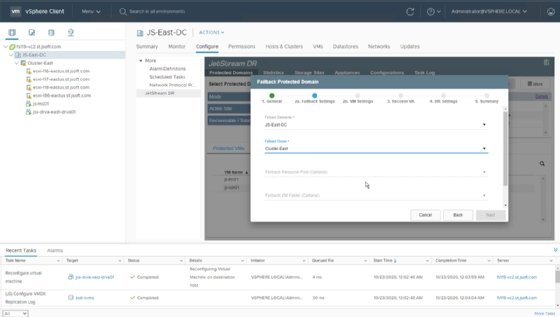
Guido Vrola - Fotolia
JetStream Software carries DR to Azure VMware Solution
JetStream DR for Azure VMware Solution allows customers to failover on-premises VMware VMs to Azure VMware Solution. The data is stored in Azure.
JetStream Software introduced low-recovery point objective disaster recovery to Azure VMware Solution customers.
JetStream DR for Azure VMware Solution is DR software for customers that want to use Azure VMware Solution as a failover site. It replicates on-premises VMware VMs to Azure Blob Storage and enables failover to Azure VMware Solution in the cloud. It can also fail over VMs in one Azure VMware Solution environment to another. The software continuously captures and replicates data using VMware IO Filters, allowing for near-zero recovery point objectives (RPOs).
The continuous replication technology in JetStream DR for Azure VMware Solution is almost identical to what's found in the JetStream DR product, which became generally available in April 2019. The base JetStream DR product is designed to work with any S3-compatible object storage target. JetStream DR for Azure VMware Solution is specifically designed to work with Microsoft Azure. It is licensed and billed through Azure Marketplace and integrated with Azure Blob Storage.
All versions of JetStream DR use VMware IO Filters for continuous data protection without installing agents and replicate the captured stream of data to object storage. The product specific to Azure VMware Solution use Azure Blob Storage as the sole repository for the VMs. The vendor claims this will give customers lower RPOs than what native tools can provide, and at a lower cost. Those native DR tools include VMware Site Recovery Manager and VMware Cloud Disaster Recovery (formerly Datrium DRaaS). JetStream DR shares similarities with third-party DR vendor Zerto. The main difference is Zerto continuously copies a journal of changes to object storage instead of replicating the entire VM.
JetStream DR for Azure VMware Solution is available for technology preview in Azure Marketplace and is priced based on the number of VMs protected. Customers will need an Azure Blob Storage subscription and a vSphere cluster running in Azure VMware Solution to use this product. It is expected to become generally available in early 2021.

JetStream president Rich Petersen said his company wants to build out disaster recovery as a service (DRaaS) capabilities through its managed service provider (MSP) partners. The combination of JetStream DR, Azure Blob Storage and Azure VMware Solution provides a DRaaS infrastructure backbone for MSPs. Although primarily aimed at addressing MSPs' demands, Petersen said enterprise customers have asked for JetStream DR to work with Azure VMware Solution, especially customers deeply invested in both Microsoft and VMware products. However, he said end customers would like to outsource DR operations to trusted providers to avoid managing it themselves.
"Increasingly, people are looking to get DR out of their own operations. They're looking for DRaaS. The demand is definitely going in that direction," Petersen said.
DR in general has been gaining attention and demand since COVID-19, according to Krista Macomber, senior analyst at Evaluator Group. Citing data from a survey conducted in April 2020, Macomber said with more employees working remotely, the tolerance for application downtime and data loss dropped. That same study also found some customers were partially activating their DR plans to enable remote work, taking advantage of some of the DR capabilities they had in place.
Macomber's research also pointed at increased interest in cloud DR and DRaaS. Customers recognizing at the beginning of the pandemic that they need to set up or improve their DR, would likely turn to the cloud because of its lower entry cost than traditional DR. Any setup where the failover site is in the cloud would be cheaper than buying and maintaining infrastructure for a second physical site. However, her research didn't indicate that customers preferred DRaaS over running their own DR, whether on-premises or cloud-based.
"We are seeing more interest in using the cloud for DR functions, especially since the pandemic hit. More apps and workloads require the level of uptime and availability that DR can provide," Macomber said.







